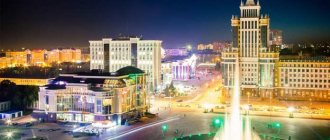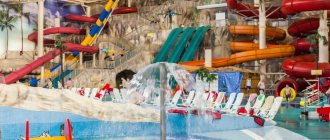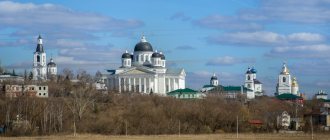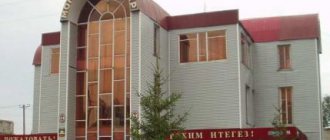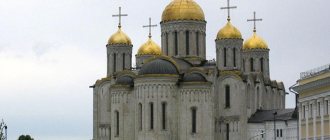Where is it located geographically?
Saransk is located almost in the very center of the European part of Russia. Geographically - in the forest-steppe zone. It was once built on the banks of the river. Saranki. Hence its name. The river was later renamed Insar. But the city retained its name. The distance between Saransk and Moscow is 513 km. It is 300 km from Samara in a straight line. Penza is located 110 km from this town.
[edit] Literature
- Voronin I. D.
Saransk.
- Saransk, 1961; Saransk: historical and economic. feature article. - Saransk, 1985; Terekhin A.F.
Meet Saransk.
- Saransk, 1986; Kuklin V.N.
Biographies of Saransk streets.
- Saransk, 1983; 1990; Notes about Saransk. XVIII-XX centuries - Saransk, 1991; Saransk: in 2 books. - Saransk, 1997; Makhaev V.B., Merkulov A.I.
Architectural history of the Mordovian region. - Ruzaevka, 1998; Saransk is the capital. 20th century - beginning of the 21st century: album. - Saransk, 2001; Saransk district. The end of the 19th - beginning of the 20th century: photo album. - Saransk, 2001; Cultural landscape of the city of Saransk (geo-ecological problems and landscape planning). - Saransk, 2002; Proletarsky district. - Saransk, 2002; Saransk during the Great Patriotic War. 1941-1945 : Sat. doc. and materials. - Saransk, 2002; Saransk: city and citizens. - Saransk, 2002.
Saransk: what region
At different times, this ancient city belonged to different provinces. Once upon a time it was part of the Kazan, Simbirsk, Azov, Penza. Today Saransk is the capital of Mordovia. In addition to it, there are 7 more cities, 13 towns and 1250 villages in this republic.
It is not difficult to get to Saransk by any type of modern transport. The city is also a major railway junction. Direct routes connect it with many other significant settlements in Russia. For example, with Moscow, Samara and Orenburg.
There is also an international airport in Saransk. Flights from here are carried out mainly to the central regions of the country, to the Urals and to the Black Sea resorts.
If you wish, it will be easy to get to Saransk by your own car. The reader now knows which region the city of Saransk belongs to. It is located in Mordovia and stands at the intersection of two federal highways - P158 and P178. The only drawback of the location of Saransk is that it is located quite far from the M5 highway leading to Moscow - 180 km.
Train Station
The Saransk-I railway station is a station in the Penza region of the Kuibyshev Railway and the main passenger station of the city. The railway station connects the passages of the Kuibyshev and Gorky railways. The number of platforms is 2, the number of tracks is 8. The station is located at st. Vokzalnaya, 7.
Popular long-distance train destinations: Moscow, Adler, Vorkuta, Samara, St. Petersburg, Barnaul, Ufa, Novorossiysk, Perm, Yekaterinburg, Novy Urengoy, Kazan, Izhevsk, Anapa, Kirov.
Also in Saransk there is a cargo station "Saransk-II". The railway station is located on the double-track section Ruzaevka-Krasny Uzel. In terms of work volume, it is a class 2 station.
A little history
Saransk was founded by archers and Cossacks in 1641 as a fortress. The main purpose of its construction was to protect the central regions from attacks by all kinds of nomadic tribes. Later, a settlement was built next to the fortress. The first inhabitants of Saransk did not live in poverty. The land in the vicinity of this city was fertile and gave good harvests. There were many animals in the local forests. Therefore, the settlement quickly became attractive to other settlers. The village began to grow rapidly and eventually turned into a town.
In 1651 the posad became a district center. In 1774, its residents supported Pugachev, who was marching on Moscow after the capture of Orenburg. Moreover, communication with the rebels was almost “traditional” for the city at that time. In 1670, it was one of the strongholds of Stepan Razin’s army.
In 1780, Saransk received city status. It became the center of the Mordovian district much later, after the revolution - in 1928. During the Second World War, city enterprises produced ammunition, uniforms and vehicles for the front. Also, several military units were formed here, hospitals and orphanages operated. 8 thousand Sarans died on the war fronts.
Religion
In Saransk, Christian and Islamic cultures successfully coexist with each other. The majority of the believing population professes Christianity, the second largest religion is Islam, and adherents of other faiths are few in number.
Currently, there are over 24 religious institutions in the city: 20 Orthodox churches and monasteries, a cathedral, a mosque, a synagogue, a Catholic parish and others.
Russian Orthodox Church
- Office of the Mordovian Metropolis
Before the revolution, the library of the Spassky Cathedral, which was destroyed during the Soviet years, was located here. After the transfer of the building to the Church in the 90s of the last century, it housed the diocesan administration of the Saransk diocese, and with the formation of the Mordovian Metropolis - the administration of the metropolis
- Cathedral of the Holy Righteous Warrior Theodore Ushakov
The decision to build the temple was made in 2001 after the canonization of the holy righteous warrior Theodore Ushakov. On March 6, 2002, the preliminary design of the cathedral was approved. On May 8, 2002, a prayer service was held and the site for the construction of the cathedral was consecrated. On September 9, 2004, a ceremony took place to lay the capsule with the relics into the foundation of the temple under construction. Construction of the cathedral was completed by mid-2006. On August 5, 2006, during a visit to Saransk, His Holiness Patriarch of Moscow and All Rus' Alexy II consecrated the cathedral in the name of the holy righteous warrior Theodore Ushakov. The Saransk Cathedral is one of the largest churches in Russia and the tallest in the Volga region. Its height is 63 meters. The cathedral can accommodate 3 thousand worshipers (total area - 900 sq. m.). Four belfries house 12 bells, the largest of which weighs 6 tons. One of the main shrines of the cathedral is the ark with particles of the relics of the holy righteous warrior Theodore Ushakov. The cathedral contains particles of the relics of many other saints.
- Temple of the Kazan Icon of the Mother of God
The site for the construction of the temple was consecrated on December 23, 2000. Its construction began in the summer of 2001 and was carried out with funds allocated from the republican, city and district budgets, donations from large industrial enterprises of the republic and private benefactors. The names of the donors are inscribed on the bricks that make up the walls of the temple. On March 13, 2005, a prayer service was held and the ground floor of the temple was consecrated, where the first service took place the next day. On June 12, 2010, Metropolitan Barsanuphius of Saransk and Mordovia performed the rite of consecration of the bells (the largest of them weighs about 4 tons). On July 21, 2011, His Holiness Patriarch Kirill of Moscow and All Rus' performed the rite of great consecration of the church in honor of the Kazan Icon of the Mother of God in the city of Saransk and the Divine Liturgy in the newly consecrated church.
- Church of St. John the Evangelist architectural monument (federal)
The church was built in 1693 in the Streletskaya settlement of Saransk on the site of a wooden church that had previously stood there. Subsequently, it was rebuilt in the 18th century, as a result of which chapels appeared at the church. In the 1810s, a bell tower was added to the church. For a short period in the 1930s and 1940s, the church was closed, then reopened in 1946, for a long time remaining the only operating Orthodox church in Saransk. It served as the second cathedral of the Penza and Saransk diocese (the first was in Penza). It is the oldest surviving building in Saransk. From 1991 to 2006 it served as the cathedral of the Saransk and Mordovian diocese.
- Church of the Life-Giving Trinity architectural monument (local significance)
The second name of the church is Trinity. The oldest part of the church was built in 1700, its construction was finally completed in 1771. The church was rebuilt several times - chapels were added, a wooden chapel was built, a bell tower, a refectory and a stone fence with metal gratings were erected. In 1896, a parish school was opened at the church, one of the best in the province. Trinity Church was closed on October 20, 1931. It was empty for some time, but by the end of the 1930s. was given over to a carpentry workshop. In 1943, the building was transferred to a prosthetic and orthopedic workshop. In the 1990s. the former church was returned to the diocese and it reopened to parishioners.
- Church of the Nativity
Built in 1745.
- Church of the Nativity of the Blessed Virgin Mary architectural monument (federal)
The second name of the church is Assumption. Built in the first half of the 18th century.
- Church of St. Nicholas the Wonderworker architectural monument (local significance)
The second name of the church is Nikolskaya. It was built in the mid-19th century (between 1840 and 1850) and was considered a suburban city. It is not original, since it was made according to a standard design from 1838. Before the revolution it was called Petropavlovskaya. During the years of Soviet power it was closed. In the 1970s it was restored and placed in the building as a museum of rare books. Since the early 1990s. became a church again.
- Church of the Nativity of John the Baptist
Built in 1800. Currently, the church houses a religious school.
- Church of Saints Cyril and Methodius Equal-to-the-Apostles
On August 25, 2012, the rite of consecration of the foundation stone for the temple was performed
- Chapel of Alexander Nevsky
The chapel was consecrated on August 3, 2000 by Alexy II. Erected in memory of the residents of Mordovia who died in wars, disasters and catastrophes.
Old Orthodox Pomeranian Church
- Samara Old Believer Community st. Lev Tolstoy, 17
Jehovah witnesses
- Kingdom Hall st. Titova, 73
Islam
- Central Mosque
- Ikhsan Mosque in the Zarechny microdistrict
- Cathedral Mosque "Uskudar" in the microdistrict "Svetotehstroy"
Administrative division
Thus, the answer to the question of what region Saransk is is clear. The city is located in Mordovia and is its capital. This ancient settlement is quite convenient for living. It will not be difficult for a guest to navigate it. At the moment, Saransk is divided into three large districts:
- Proletarian.
- Leninist.
- October.
As part of the municipal development, it forms the urban district of Saransk, which includes 3 towns and 13 villages.
Content
- 1. History
- 2 Administrative and municipal status
- 3 Climate
- 4 Industry
- 5 Demographics
- 6 Culture and religion
- 7 Sports
- 8 Cityscape and architecture
- 9 Transport 9.1 Airport 9.1.1 Bus service
- 9.1.2 Private cars
- 12.1 Notes
Population
According to statistics, by 2022, 314,389 people will live in Saransk. The demographic situation here is considered relatively stable. Such a serious outflow of population as in other provincial towns is not observed here. But at the same time, the number of visitors is growing very slowly. For example, in 2016, 307,698 people were officially registered in the city.
We found out in what region Saransk is located these days. This is the Republic of Mordovia. However, oddly enough, the majority of the population in the city - almost 2/3 - are Russians. Also, a lot of Erzyans and Mokshans (branches of the Mordovian ethnic group) live here. Another fairly large group of the population is the Tatars. There are no interethnic conflicts observed in Saransk. The only thing is that there is a small Mordovian organization that considers Russians oppressors and even publishes its own newspaper.
Climate
Saransk has a relatively cold version of the humid continental climate (Köppen: Dfb)[14] with warm but not hot summers and cold winters, with average temperatures well below zero for five months of the year. Transition periods are extremely short, with only April and October having average temperatures between 0 °C (32 °F) and 10 °C (50 °F).
| Climate data for Saransk | |||||||||||||
| Month | Jan | Feb | Mar | Apr | May | Jun | Jul | Aug | Sep | October | But I | December | Year |
| Record high °C (°F) | 4.8 (40.6) | 14.0 (57.2) | 16.3 (61.3) | 28.9 (84.0) | 34.0 (93.2) | 36.1 (97.0) | 38.0 (100.4) | 39.4 (102.9) | 32.3 (90.1) | 23.0 (73.4) | 13.9 (57.0) | 7.1 (44.8) | 39.4 (102.9) |
| Average high °C (°F) | −5.0 (23.0) | −4.0 (24.8) | 0.0 (32.0) | 10.0 (50.0) | 18.0 (64.4) | 22.0 (71.6) | 24.0 (75.2) | 23.0 (73.4) | 17.0 (62.6) | 9.0 (48.2) | 1.0 (33.8) | −4.0 (24.8) | 9.3 (48.7) |
| Daily average °C (°F) | −8.5 (16.7) | −8.0 (17.6) | −3.0 (26.6) | 5.5 (41.9) | 12.5 (54.5) | 17.0 (62.6) | 19.0 (66.2) | 17.5 (63.5) | 12.5 (54.5) | 6.0 (42.8) | −1.0 (30.2) | −6.5 (20.3) | 5.3 (41.5) |
| Average low °C (°F) | −12.0 (10.4) | −12.0 (10.4) | −6.0 (21.2) | 1.0 (33.8) | 7.0 (44.6) | 12.0 (53.6) | 14.0 (57.2) | 12.0 (53.6) | 8.0 (46.4) | 3.0 (37.4) | −3.0 (26.6) | −9.0 (15.8) | 1.3 (34.3) |
| Record low °C (°F) | −34.0 (−29.2) | −36.0 (−32.8) | −24.6 (−12.3) | −17.6 (0.3) | −5.4 (22.3) | 1.1 (34.0) | 5.7 (42.3) | 0.0 (32.0) | −5.0 (23.0) | −14.0 (6.8) | −24.0 (−11.2) | −34.0 (−29.2) | −36.0 (−32.8) |
| Average precipitation mm (inches) | 35 (1.4) | 29 (1.1) | 35 (1.4) | 37 (1.5) | 47 (1.9) | 71 (2.8) | 59 (2.3) | 52 (2.0) | 52 (2.0) | 49 (1.9) | 40 (1.6) | 40 (1.6) | 546 (21.5) |
| Average number of days with precipitation (≥ 0.1 mm) | 15.0 | 12.2 | 13.0 | 11.3 | 12.8 | 16.5 | 15.7 | 13.5 | 11.9 | 12.7 | 12.7 | 14.9 | 162.2 |
| Source: [15] | |||||||||||||
Education, culture and economics
To date, Saransk has one university, three universities, a branch of the Humanities Academy, several colleges, technical schools and schools. Saransk residents do not remain aloof from cultural life. There are five theaters alone in the city. Also on the territory of Saransk there is a cultural center named after. Gerard Depardieu. Of course, there are cinemas, museums and libraries in the city.
[edit] City districts
Saransk consists of 3 districts.
Leninsky district.
Formed in 1972. Since 1985, it occupies the central and southern parts of the city beyond Saranka and the southwest. Area 25 km2, population 114 thousand people. (2002). Here are the residence of the Head of the Republic of Moldova, the executive (see House of the Republic) and legislative (see State Assembly of the Republic of Moldova) authorities of the republic. Main streets: Sovetskaya, Bolshevistskaya, Proletarskaya, Botevgradskaya, Kommunisticheskaya, named after. L. N. Tolstoy, A. I. Polezhaev, V. I. Lenin Avenue, 50 years of October. The industrial potential consists of about 30 large enterprises in various industries. There are the Main Post Office, Mordovia State University, 11 secondary schools, 5 gymnasiums, 3 lyceums, 6 secondary specialized educational institutions, 26 preschool institutions, 14 hospitals and dispensaries, 7 clinics, 4 theaters, 6 museums, 10 libraries, 2 cultural and recreation parks, “Palace of Sports”, 3 sports and recreation complexes, 470 trade enterprises, 8 markets. First secretaries of the RK CPSU: since 1972 - S. I. Davydov, since 1980 - A. M. Umnyashkin, since 1983 - N. A. Utkin, since 1985 - V. N. Tarasov, with 1988 - P. N. Mezhnyakov, in 1989-1990 - A. A. Artyomov. Chairman of the Executive Committee: since 1972 - V. T. Filyotkin; since 1973 - Yu. N. Repin; since 1976 - A. M. Umnyashkin; since 1980 - N. A. Utkin; since 1984 - N. P. Kolabkin; since 1985 - S. F. Shcherbakov, Kh. N. Shataev; in 1989-1992 - N.I. Rasseev. Head of administration (in 1992-1994, since 2004), district (in 1994-2003): since 1992 - Yu. G. Domnin.
Proletarsky district.
Formed in 1972. Since 1985, it occupies mainly the northwestern part of the city. Area 27 km2, population 94 thousand people. (2002). The main residential area is Svetotekhnika. Main streets: E. A. Veselovsky, I. S. Kovalenko, A. S. Pushkin, Pobeda, 60 Let Oktyabrya Avenue. There are about 20 industrial enterprises, 12 secondary schools, a gymnasium, a lyceum, 6 vocational schools, 19 preschool institutions, children's art and children's music schools, 5 libraries, a center for the aesthetic education of children, 7 teenage clubs, a hospital, 4 clinics, a sports and recreation complex, 127 trade enterprises, 2 markets. First secretaries of the RK CPSU: since 1972 - M. G. Vashurkin; since 1979 - Yu. M. Lyupaev; since 1987 - A. N. Poltoratsky; in 1988-1990 — V.D. Volkov. Chairman of the Executive Committee: since 1972 - G. V. Chirshev; since 1977 - S. F. Sorokin; With. 1981 - I. M. Devaev; since 1984 - M. F. Safonkin; since 1985 - L. A. Mayorov; since 1987 - A. I. Zhiltsov; in 1989-1992 — I. Ya. Nenyukov. Head of administration (in 1992-1994, since 2004), district (in 1994-2003): since 1992 - I. Ya. Nenyukov; since 1995 - A. I. Katkov; since 1998 - S. N. Nishchev; since 2004 - A. M. Tyurkin, since 2010 - M. M. Lunin.
Oktyabrsky district.
Formed in 1985. Occupies territory in the northern, eastern and southeastern parts of the city. Area 28 km2, population 103 thousand people. (2002), of which 7 thousand live in 13 rural settlements. The district includes Zykovo, Lukhovka, Nikolaevka, Yalga. Large residential areas: Posop, CHPP-2, named after. Yu. A. Gagarin, “Khimmash”, “Yuzhny”. Main streets: Volgogradskaya, Gorzhuvskaya, Leningradskaya, Energeticheskaya, A.V. Kosareva, I.A. Likhacheva, 70 Let Oktyabrya Avenue. In the area there are 19 industrial enterprises, State Unitary Enterprise RM “Teplichnoe”, “Lukhovskoe”, “Yalga”, “1 Maya”, LLC “Agrofirm “Nikolaevskaya””, Uchkhoz, 2 K(F)H - “Kildeev” and “Rosa”. They specialize in the production of meat, milk, and vegetables. GTS and Moscow State Pedagogical Institute are functioning. M. E. Evsevieva, Saransk Cooperative Institute, 24 general education day and 1 evening schools, college, 2 lyceums, 6 children's art and children's music schools, and art schools, Center for Children's Creativity, 19 preschool institutions, 4 libraries, 9 rural Houses of Culture and clubs, 4 hospitals, 3 clinics, 194 trade enterprises, 2 markets. First secretaries of the RK CPSU: since 1985 - N. A. Utkin; in 1988-1990 — Yu. I. Rybin. Chairman of the Executive Committee: since 1985 - S. F. Shcherbakov; in 1989-1991 - G. A. Gryzunova. Head of administration (in 1992-1994, since 2004), district (in 1994-2003): since 1992 - A. I. Zamotaev, since 1997 - I. P. Volgushev.
